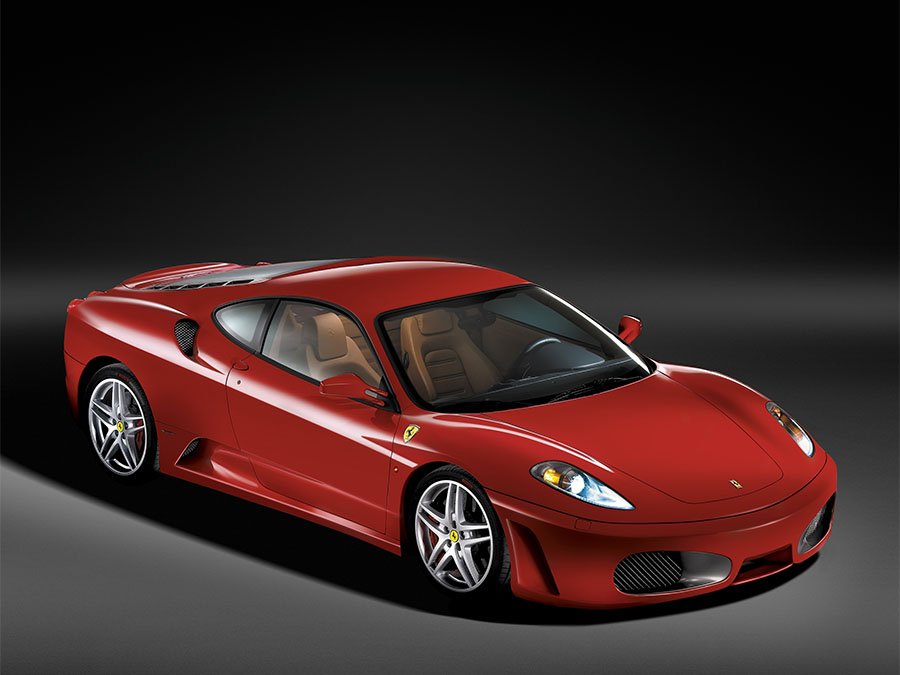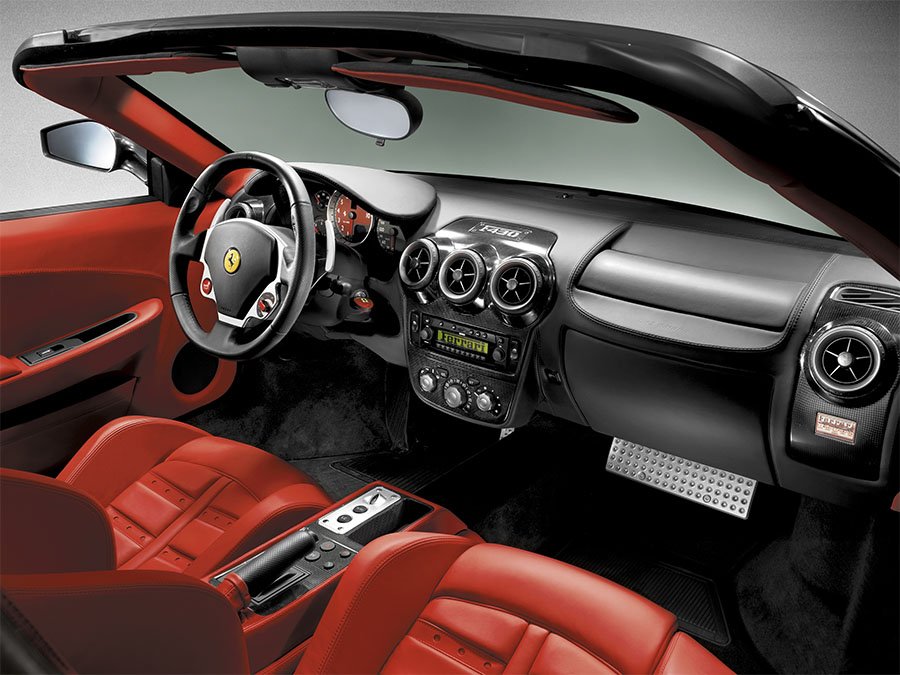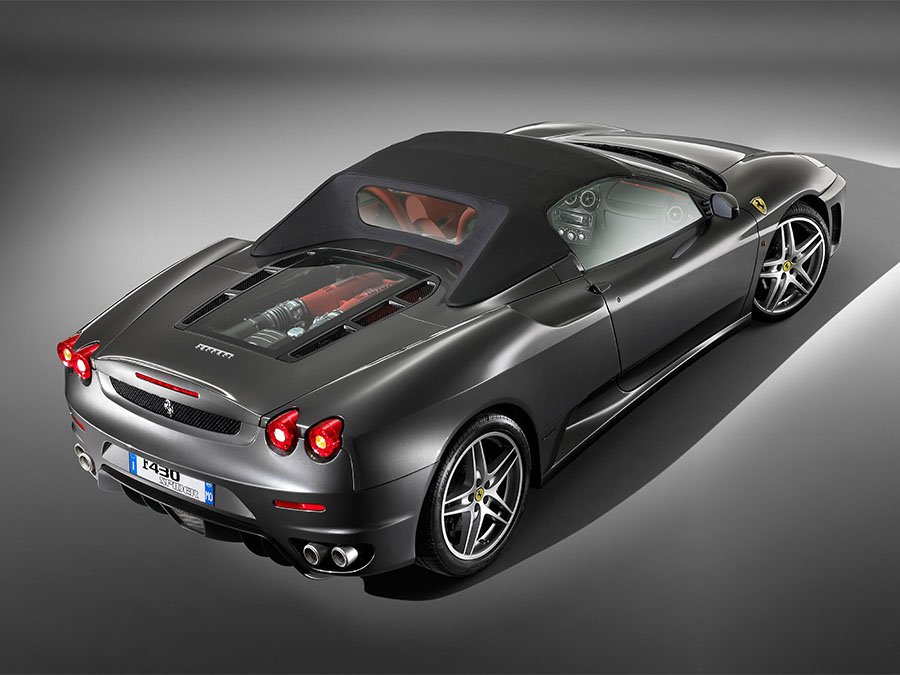Guide: Ferrari F430 - a Historical & Technical Appraisal
/BACKGROUND
Four-and-a-half years after the mould-breaking 360 Modena had broken cover at Geneva in March 1999, Ferrari launched a heavily revised replacement to occupy their entry-level two-seat sector.
Code-named Tipo F131, the resultant F430 was unveiled in Coupe form at the Paris Motor Show in September 2004.
Like its predecessor, the F430 was built around an aluminium spaceframe chassis whereas the older 348 and F355 had utilised pressed steel monocoques. Going even further back in time, the 328, 308 and Dino 246 / 206 built from the late 1960s to the late 1980s had been based on traditional tubular steel frames.
Together, this line of junior models with their V6 and V8 engines had sold in vastly higher numbers than Ferrari’s more expensive 12 cylinder offerings. This in turn put the firm on a more sound financial footing and helped pay for its various racing programmes which in recent years had focused solely on Formula 1.
It was from Ferrari’s F1 participation that many of the F430’s technical innovations stemmed; a brand new 4.3-litre V8 brimmed with advanced Formula 1-derived technology while air flow around and underneath the car was similarly influenced by lessons learned from the top level of motor sport. Another exciting F1-inspired feature was a new steering wheel-mounted ‘Manettino’ control interface similar to that of the Enzo.
The F430’s development coincided with a rich vein of form for Ferrari in F1 thanks to the dream team of number one driver Michael Schumacher, technical director Ross Brawn, chief designer Rory Byrne and general manager Jean Todt. Together, they took the Maranello equipe to six straight Constructors’ titles and five consecutive Drivers’ championships between 1999 and 2004.
Compared to the outgoing 360, Ferrari claimed their latest model was around 70% new with the only interchangeable components having been the front lid, doors, roof and glass.
The F430 was initially available in Coupe trim although a Spider followed soon after following its launch at the Geneva Motor Show in March 2005.
These two variants joined a Ferrari line up that included the two-seat 575M (soon to be replaced by the 599), the four-seat 612 Scaglietti and the limited edition Enzo (all of which were V12-powered).
CHASSIS
The F430 was based around a 360-derived aluminium spaceframe constructed at the Scaglietti works in Modena. Although all of its fundamental characteristics were carried over (such as wheelbase, track, width and height), this latest iteration was 20% stiffer than before and had a reinforced front end to comply with the latest crash regulations.
Weight rose by 60kg but the more rigid chassis had a positive effect on handling.
Independent suspension was via super lightweight double wishbones with coil springs and the latest electronically controlled Skyhook adaptive dampers that adjusted to various parameters such as steering, road speed, braking and acceleration to optimise handling.
Anti-roll bars were fitted at either end. Anti-dive and anti-squat geometry was also installed.
The 360’s cross-drilled and ventilated brake discs were enlarged to a 350mm diameter. Four-piston light alloy calipers were fitted all round along with the latest Bosch ABS.
Wheel diameter went from 18 to 19-inches but width stayed the same (7.5-inches front and 10 at the rear). The F430’s handsome new five twin-spoke light alloy rims were originally shod with Bridgestone Potenza tyres.
A new speed-sensitive power steering system gave improved feel, particularly above 100mph.
As before, duel fuel tanks with a combined 95-litre capacity were fitted either side of the engine, up against the rear bulkhead.
ENGINE / TRANSMISSION
Whereas the 360 had used an enlarged and uprated evolution of the F355 motor (which could trace its roots back to the early 1970s), the F430 was powered by a brand new Tipo F136 engine which had been jointly developed by Ferrari and Maserati.
Like those F136 engine fitted to concurrent Maseratis of the time, the F136 E unit found in the F430 was an all-alloy 90° V8 with dual overhead camshafts per bank and four valves per cylinder. It also featured a dry-sump lubrication with the sump and main bearings integrated within a single casing.
However, instead of a cross-plane crankshaft as used by Maserati, the F430’s engine incorporated a lighter, more responsive flat-plane crank with 180° between throws (as per the 360). Other reciprocating parts were also lightweight items to include the forged aluminium pistons and titanium connecting rods.
To increase thermal efficiency and produce more power, compression was hiked from 11.1:1 (or 11.0:1 on the Quattrporte) to 11.3:1.
The dual overhead camshafts per bank featured variable timing on both the inlet and exhaust cams. The four valve heads and intake trumpets were carried over from Ferrari’s Formula 1 engines and the variable valve timing system was imported from the Enzo. A variable airflow plenum chamber was also fitted.
All F136 engines of the period shared the same compact and light weight aluminium block; for the F136 E displacement was taken out from 4244cc to 4308cc (a gain of 64cc). This was achieved by a 1.2mm lengthening of the stroke while the cylinder bores were kept at a diameter of 92mm.
Engine management was via the latest Bosch Motronic ME7 software (with a separate system for each cylinder bank).
In this configuration, the F430 produced a peak output of 483bhp at 8500rpm and 343lb-ft at 5250rpm.
For comparison, the outgoing 360 had produced 394bhp at 8500rpm and 275lb-ft at 4750rpm.
Ferrari supplied the F430 with a choice of two six-speed gearboxes: a conventional manual (standard) or an F1-style paddle-shift (optional).
In both cases, the first five ratios were the same as the 360, sixth was longer and a shorter final drive ratio was installed. There was also a new smaller twin-plate clutch that was much more durable than before.
The F1 gearbox was built on Ferrari’s behalf by Graziano Trasmissioni and offered the driver both fully automatic and manual shifting via paddles mounted behind the steering wheel.
One particularly exciting new feature found on the F430 was its Manettino toggle switch located on the bottom-right of the steering wheel. Settings for Race, Sport, Damp, Ice and Disengage tuned into the car’s new E-Diff electronic differential with each mode adjusting the settings of the adaptive dampers, the F1 shift time, throttle response, traction control, stability control and E-Diff.
If disengaged, the E-Diff acted like a conventional limited-slip differential.
BODYWORK
Whereas all of Ferrari’s prior two-seat junior models had been styled by Pininfarina, the F430 was a collaboration between the Turin styling house and Frank Stephenson who was Director of Ferrari-Maserati Concept Design and Development.
The new model continued the trend for large intakes carved out from either side of the front bumper; for this latest model inspiration was taken from Carlo Chiti’s famous twin nostril arrangement that had been briefly adopted on most of Ferrari’s F1 and Prototype racing cars of the early 1960s.
Located in between the Chiti-style nostrils (to which satin black inlays were applied) was a lower spoiler that directed air to the new flat underbody.
The F430’s glass-covered bi-xenon headlights started a decade-long trend for stacked headlights. Like the 360, the Fastback cabin profile put the engine on full display under a glass cover.
Down each flank were a trio of large ducts and vents – one ahead of each front wheel, one along the sill and another atop the rear fenders. The driver’s exterior mirror was embossed with a prominent F430 script.
At the back, the F430’s styling was clearly inspired by the Enzo with its semi-exposed tail lights, vented fascia and massive underbody diffuser.
Thanks to a major step forward in aerodynamics, the F430 generated 50% less lift than its predecessor and almost double the downforce.
With the exception of its plastic-composite bumper assemblies, the F430’s all-aluminium body panels were riveted and welded together.
INTERIOR
Although the F430 retained almost exactly the same cockpit layout as the 360, it was comprehensively redesigned for a more updated appearance.
Behind the new three-spoke steering wheel with its bright red engine start button and Manettino toggle switch was another five gauge instrument binnacle with a quintet of analogue dials. Mounted in the centre was a 10,000rpm rev counter flanked to the right by a 360kmh / 220mph speedometer. Off to the left were a trio of small read outs for water temperature, oil temperature and fuel.
The dash, seats, door cards and centre console were all new.
Much less aluminium was used in line with current trends; this once fashionable material had instead been replaced mostly with leather and what did remain was a much darker colour than used previously.
Electric seats were fitted as standard along with electric windows, electric mirrors, air-conditioning, fine leather upholstery, a full complement of airbags and a high end audio system.
OPTIONS
In addition to the aforementioned F1 paddle-shift gearbox, F430 buyers could enhance their car with a wide array of optional extras.
Aside from one-off personalisation of paint, leather and carpet through the Carrozzeria Scaglietti programme, the most expensive upgrade was carbon-ceramic brakes designed to offer greater fade-resistance than the standard items (particularly on track).
Other performance-focused extras included lightweight Challenge-style BBS wheels, carbonfibre racing seats, four-point safety harnesses and a leather-trimmed aluminium roll cage. However, the harnesses and roll cage were only available in certain markets having been outlawed in North America and the Middle East.
Exterior options included Scuderia Ferrari wing shields and a choice of red, yellow or natural aluminium-finishes for the brake calipers.
For the cockpit there was Daytona-style seat upholstery with perforated inserts (also available in duo-tone), an exposed carbonfibre or aluminium interior pack, a leather rear bulkhead panel, a yellow or red-backed rev counter, contrast stitching, a set of fitted luggage and an uprated stereo system complete with sub-woofer, satellite navigation and Bluetooth connectivity.
Later on, Ferrari began to offer lightweight wheels from the 430 Scuderia and exposed carbonfibre panels for the sills, fuel filler door, engine cover, upper tail fascia panel, exterior mirrors, front spoiler, door catches and engine bay.
WEIGHT / PERFORMANCE
As a result of its beefed up chassis the F430 weighed 60kg more than the outgoing 360 (1450kg as opposed to 1390kg).
Nevertheless, the 0-62mph time dropped from 4.4 seconds to 4.2 seconds in manual trim and from 4.2 seconds to 4 seconds flat in F1 trim.
Top speed went from 183mph to 196mph.
F430 SPIDER
Six months after the F430 Coupe arrived, Ferrari unveiled a Spider variant at the Geneva Motor Show in March 2005.
Mechanically the Spider was identical to the Coupe, but in order to compensate for the lack of a roof the aluminium chassis was strengthened and the body was reinforced with a beefed up windscreen and a pair of roll over bars behind the seats. All of this added an extra 70kg of ballast (1520kg).
The electric roof took less than 20 seconds to raise or lower and, when retracted, stowed flush beneath a metal body coloured tonneau. Meshed air-deflectors within the roll-over bars and a Plexiglass windbreak in between the seats counteracted wind noise and buffeting.
As per the Coupe, the engine was on display below a glass-covered hatch.
0-62mph times were a tenth off the Coupe and top speed was 3mph slower (193mph).
With the exception of the leather-covered roll cage, all the same optional extras were offered on the Spider.
PRODUCTION CHANGES
Although Ferrari made no major changes to the F430 during its five-year lifespan, myriad minor details were updated.
Of these, perhaps the most notable was the switch to exhaust manifolds that were less prone to cracking in late 2007. Other engine-related parts that were changed at various times included the crankcases, cylinder heads, camshafts, valve seats, ignition coils, injectors, ECU, intake manifolds, water pump and oil pump. The F1 gearbox and E-Diff were also modified along with ABS / ASR software and the optional carbon brake discs / calipers. However, none of this made any difference to recorded performance figures or engine output.
Cosmetically, Ferrari installed a new airbag assembly for the steering wheel, new sun visors, new door frames and locks, a new rear view mirror and updated the stereo / satellite-navigation.
New trim was also installed for the front storage compartment.
END OF PRODUCTION
Ferrari are still yet to publish precise production numbers for any of the regular F430 variants but it is widely assumed that around 14,000 were completed with the slight majority having been Coupes.
Text copyright: Supercar Nostalgia
Photo copyright: Ferrari - https://www.ferrari.com









































